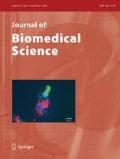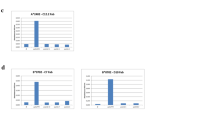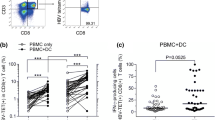Abstract
T cell clones specific for hepatitis B core (HBcAg) and e (HBeAg) antigens of hepatitis B virus (HBV) were generated from liver infiltrates of HBeAg-positive patients. Analyzed with a panel of overlapping synthetic peptides spanning the complete sequences of HBcAg and HBeAg, eight clones responded specifically to the e2 peptide (PAYRPPNAPIL; amino acid residues 130–140 of HBcAg and HBeAg), which was doubly restricted by class I and II molecules. A preferential usage of the T cell receptor (TCR) α chain variable (Vα) gene was found: Vα12.1 for five HLA-Cw9(3)-restricted cytotoxic T lymphocyte (CTL) clones, and Vα7.1 for three other HLA-DRw52-restricted type 1 helper T cell (Th1) clones. Although heterogeneous in the usage of TCR α chain joining region (Jα) segments, their junctional-region sequences revealed conserved hydrophilic serine residues in seven of the eight e2-specific T cell clones. Single alanine substitution of the centrally located and the only hydrophilic asparagine residue of e2 peptide abrogated T cell responsiveness. The nonstimulatory e2 analogue could competitively inhibit e2-specific responses. These results demonstrate that both CTL and Th1 clones recognizing a determinant of HBcAg and HBeAg are present in the liver of chronic hepatitis B patients. The preferential Vα gene usage and the expression of conserved residues in junctional-region sequences of TCRα chains by viral-peptide-specific, intrahepatic T cells may provide a T cell mechanism of HBV immunopathogenesis.
Similar content being viewed by others
References
Adorini L, Nagy ZA. Peptide competition for antigen presentation. Immunol Today 11:21–24;1990.
Argos P, Fuller SD. A model for the hepatitis B virus core protein: Prediction of antigenic sites and relationship to RNA virus capsid proteins. EMBO J 7:819–824;1989.
Barnaba V, Franco A, Alberti A, Balsano C, Benvenuto R, Balsano F. Recognition of hepatitis B virus envelope proteins by liver infiltrating T lymphocytes in chronic HBV infection. J Immunol 143:2650–2655;1989.
Barnaba V, Franco A, Alberti A, Benvenuto R, Balsano F. Selective killing of hepatitis B envelope antigen-specific B cells by class I-restricted, exogenous antigen-specific T lymphocytes. Nature 345:258–260;1990.
Beasley RP, Hwang LY, Lin CC, Chien CC. Hepatocellular carcinoma and hepatitis B virus. Lancet ii:1129–1133;1981.
Benner KG, Lee RG, Keeffe EB, Lopez RR, Sasaki AW, Pinson CW. Fibrosing cytolytic liver failure secondary to recurrent hepatitis B after liver transplantation. Gastroenterology 103:1307–1312;1992.
Bertoletti A, Chisari FV, Penna A, Galati L, Cavalli A, Missale G, Fowler P, Fiaccadori F, Ferrari C. The optimal epitope recognized by HLA-A2 restricted cytotoxic T cells is defined by 10 amino acid sequence of the hepatitis B virus (HBV) nucleoprotein. 8th International Congress of Immunology, Budapest, Hungary, Aug 23–28, 1992, W-55, No 3 (abstract).
Blue ML, Daley JF, Levine H, Craig KA, Schlossman SF. Biosynthesis and surface expression of T8 by peripheral blood T4+ cells in vitro. J Immunol 137:1202–1207;1986.
Böyum A. Isolation of mononuclear cells and granulocytes from human blood. Scand J Clin Lab Invest 21 (suppl 97):77–89;1968.
Carreno BM, Turner RV, Biddison WE, Coligan JE. Overlapping epitopes that are recognized by CD8+ HLA class I-restricted and CD4+ class II-restricted cytotoxic T lymphocytes are contained within an influenza nucleoprotein peptide. J Immunol 148:894–899;1992.
Chen DS. Hepatitis B virus infection, its sequelae, and prevention in Taiwan. In: Okuda K, Ishak KG, eds. Neoplasms of the liver. Tokyo, Springer, 71–80;1987.
Chen DS. From hepatitis to hepatoma: Lessons learned from type B hepatitis. Science 262:369–370;1993.
Chen HL, Chiu TS, Chen PJ, Chen DS. Cytogenetic studies on human liver cancer cell lines. Cancer Genet Cytogenet 65:161–166;1993.
Chen PJ, Chen CR, Sung JL, Chen DS. Identification of a doubly spliced viral transcript joining the separated domains for putative protease and reverse transcriptase of hepatitis B virus. J Virol 63:4165–4171;1989.
Chicz RM, Urban RG, Lane WS, Gorga JC, Stern LJ, Vignali DAA, Strominger JL. Predominant naturally processed peptides bound to HLA-DR1 are derived from MHC-related molecules and are heterogeneous in size. Nature 358:764–768;1992.
Chomczynski P, Sacchi N. Single-step method of RNA isolation by acid guanidinium thiocyanate-phenol-chloroform extraction. Anal Biochem 162:156–159;1987.
Chu CM, Liaw YF. Intrahepatic distribution of hepatitis B surface and core antigens in chronic hepatitis B virus infection: Hepatocyte with cytoplasmic/membranous hepatitis B core antigen as a possible target for immune hepatocytolysis. Gastroenterology 92:220–225;1987.
Chu CM, Shyu WC, Kuo RW, Liaw YF. HLA class I antigen display on hepatocyte membrane in chronic hepatitis B virus infection: Its role in the pathogenesis of chronic type B hepatitis. Hepatology 7:1311–1316;1987.
Colucci G, Beazer Y, Cantaluppi C, Tackney C. Identification of a major hepatitis B core antigen (HBcAg) determinant by using synthetic peptides and monoclonal antibodies. J Immunol 141:4376–4380;1988.
Davies TF, Martin A, Concepcion ES, Graves P, Cohen L, Ben-Nun A. Evidence of limited variability of antigen receptors on intra-thyroidal T cells in autoimmune thyroid disease. N Engl J Med 325:238–244;1991.
DeLisi C, Berzofsky J. T cell antigenic sites tend to be amphipathic structures. Proc Natl Acad Sci USA 82:7048–7052;1985.
Del Prete GF, De Carli M, Mastromauro C, Biagiotti R, Macchia D, Falagiani P, Ricci M, Romagnani S. Purified protein derivative ofMycobacterium tuberculosis and excretory-secretory antigen(s) ofToxocara canis expand in vitro human T cells with stable and opposite (type 1 T helper or type 2 T helper) profile of cytokine production. J Clin Invest 88:346–350;1991.
DerSimonian H, Band H, Brenner MB. Increased frequency of T cell receptor Vα12.1 expression on CD8+ T cells: Evidence that Vα participates in shaping the peripheral T cell repertoire. J Exp Med 174:639–648;1991.
Doherty PC, Allen W, Eichelberger M, Carding SR. Roles of αβ and γδ T cell subsets in viral immunity. Annu Rev Immunol 10:123–151;1992.
Duke RC. Self recognition by T cell. 1: By-stander killing of target cells bearing syngeneic MHC antigens. J Exp Med 170:59–71;1989.
Ehata T, Omata M, Yokosuka O, Hosoda K, Ohto M. Variations in codons 84–101 in the core nucleotide sequence correlate with hepatocellular injury in chronic hepatitis B virus infection. J CLin Invest 89:332–338;1992.
Falk K, Rötzschke O, Rammensee HG. Specificity of antigen processing for MHC class I-restricted presentation is conserved between mouse and man. Eur J Immunol 22:1323–1326;1992.
Ferrari C, Bertoletti A, Penna A, Cavalli A, Valli A, Missale G, Pilli M, Fowler P, Giuberti T, Chisari FV, Fiaccadori F. Identification of immunodominant T cell epitopes of the hepatitis B virus nucleocapsid antigen. J Clin Invest 88:214–222;1991.
Ferrari C, Mondelli MU, Penna A, Fiaccadori F, Chisari FV. Functional characterization of cloned intrahepatic, hepatitis B virus nucleoprotein-specific helper T cell lines. J Immunol 139:539–544;1987.
Ferrari C, Penna A, Giuberti T, Tong MJ, Ribera E, Fiaccadori F, Chisari FV. Intrahepatic, nucleocapsid antigen-specific T cells in chronic active hepatitis B. J Immunol 139:2059–2065;1987.
Guilhot S, Fowler P, Portillo G, Margolskee RF, Ferrari C, Bertoletti A, Chisari FV. Hepatitis B virus (HBV)-specific cytotoxic T-cell response in humans: Production of target cells by stable expression of HBV-encoded proteins in immortalized human B-cell lines. J Virol 66:2670–2678;1992.
Hahn YS, Hahn CS, Braciale VL, Braciale TJ, Rice CM. CD8+ T cell recognition of an endogenously processed epitope is regulated primarily by residues within the epitope. J Exp Med 176:1335–1341;1992.
Hoffmann RM, Pape GR, Rieber P, Eisenburg J, Döhrmann J, Zachoval R, Paumgartner G, Riethmüller G. Cytolytic T cell clones derived from liver tissue of patients with chronic hepatitis B. Eur J Immunol 16:1635–1638;1986.
Hsu HC, Su IJ, Lai MY, Chen DS, Chang MH, Chuang SM, Sung JL. Biologic and prognostic significance of hepatocyte hepatitis B core antigen expressions in the natural course of chronic hepatitis B virus infection. J Hepatol 5:45–50;1987.
Jorgensen JL, Esser U, Groth BF, Reay PA, Davis MM. Mapping T-cell receptor-peptide contacts by variant peptide immunization of single-chain transgenics. Nature 355:224–230;1992.
Jorgensen JL, Reay PA, Ehrich EW, Davis MM. Molecular components of T-cell recognition. Annu Rev Immunol 10:836–873;1992.
Kamogawa Y, Yamauchi K, Obata H, Chisaka O, Matsubara K, Hepatitis B virus-DNA transfected myeloma cell-specific cytotoxic T cells in chronic hepatitis B patients. Virology 191:321–326;1992.
Kaye J, Kersh G, Engel I, Hedrick SM. Structure and specificity of the T cell antigen receptor. Semin Immunol 3:269–281;1991.
Klein MH, Concannon P, Everett M, Kim LDH, Hunkapiller T, Hood L. Diversity and structure of human T-cell receptor α-chain variable region genes. Proc Natl Acad Sci USA 84:6884–6888;1987.
Kropshofer H, Max H, Müller CA, Hesse F, Stevanovic S, Jung G, Kalbacher H. Self-peptide released from class II HLA-DR1 exhibits a hydrophobic two-residue contact motif. J Exp Med 175:1799–1803;1992.
Lee CJ, Lee PC, Tai JJ, Lee PH. Human leucocyte antigens in inhabitants of Taiwan. J Formosan Med Assoc 89:526–533;1990.
Liaw YF, Chu CM, Su IJ, Huang MJ, Lin DJ, Chang-Chien CS. Clinical and histological events preceding hepatitis B e antigen seroconversion in chronic type B hepatitis. Gastroenterology 84:216–219;1983.
Maeji NJ, Bray AM, Geysen HM. Multi-pin peptide synthesis strategy for T cell determinant analysis. J Immunol Methods 134:23–33;1990.
Maruyama T, McLachlan A, Iino S, Koike K, Kurokawa K, Milich DR. The serology of chronic hepatitis B infection revisited. J Clin Invest 91:2586–2595;1993.
Merrifield RB. Solid phase synthesis. Science 232:341–347;1986.
Milich DR, Hughes JL, McLachlan A, Thornton GB, Moriarty A. Hepatitis B synthetic immunogen comprised of nucleocapsid T-cell sites and an envelope B-cell epitope. Proc Natl Acad Sci USA 85:1610–1614;1988.
Milich DR, McLachlan A, Moriarty A, Thornton GB. Immune response to hepatitis B virus core antigen (HBcAg): Localization of T cell recognition sites within HBcAg/HBeAg. J Immunol 139:1223–1231;1987.
Missale G, Redeker A, Person J, Fowler P, Guilhot S, Schlicht HJ, Ferrari C, Chiasir FV. HLA-A31- and HLA-Aw68-restricted T cell responses to a single hepatitis B virus nucleocapsid epitope during acute viral hepatitis. J Exp Med 177:751–762;1993.
Moretta A, Pantaleo G, Moretta L, Cerottini JC, Mingari MC. Direct demonstration of the clonogenic potential of every human peripheral blood T cell: Clonal analysis of HLA-DR expression and cytolytic activity. J Exp Med 157:743–754;1983.
Mutch DA, Rodda SJ, Benstead M, Valerio RM, Geysen HM. Effects of end groups on the stimulatory capacity of minimal length T cell determinant peptides. Pept Res 4:132–137;1991.
Nalefski EA, Kasibhatla S, Rao A. Functional analysis of the antigen binding site on the T cell receptor α chain. J Exp Med 175:1553–1563;1992.
Newcomb JR, Cresswell P. Characterization of endogenous peptides bound to purified HLA-DR molecules and their absence from invariant chain-associated αβ dimers. J Immunol 150:449–507;1993.
Oksenberg JR, Stuart S, Begovich AB, Bell RB, Erlich HA, Steinman L, Bernard CCA. Limited heterogeneity of rearranged T-cell receptor Vα transcripts in brains of multiple sclerosis patients. Nature 345:344–346;1990.
Peters M, Vierling J, Gershwin ME, Milich DR, Chisari FV, Hoofnagle JH. Immunology and liver. Hepatology 13:977–994;1991.
Rammensee HG, Falk K, Rötzschke O. Peptides naturally presented by MHC class I molecules. Annu Rev Immunol 11:213–244;1993.
Roman-Roman S, Ferradini L, Azocar J, Genevée C, Hercend T, Triebel F. Studies on the human T cell receptor α/β variable region genes. I: Identification of 7 additional Vα subfamilies and 14 Jα gene segments. Eur J Immunol 21:927–933;1991.
Salfeld J, Pfaff E, Noah M, Schaller H. Antigenic determinants and functional domains in core antigen and e antigens from hepatitis B virus. J Virol 63:798–808;1989.
Sanger F, Nicklen S, Coulson AR. DNA sequencing with chain-terminating inhibitors. Proc Natl Acad Sci USA 74:5463–5467;1977.
Sharrock CEM; Kaminski E, Man S. Limiting dilution analysis of human T cells: A useful clinical tool. Immunol Today 11:281–285;1990.
Standring DN, Ou JH, Masiarz FR, Rutter WJ. A signal peptide endoced within the precore region of hepatitis B virus directs the secretion of a heterogeneous population of e antigens inXenopus ooxytes. Proc Natl Acad Sci USA 85:8405–8409;1988.
Tabor S, Richardson CC. DNA sequence analysis with a modified bacteriophage T7 DNA polymerase. Proc Natl Acad Sci USA 84:4767–4771;1987.
Takahashi H, Germain RN, Moss B, Berzofsky JA. An immunodominant class I-restricted cytotoxic T lymphocyte determinant of human immunodeficiency virus type 1 induces CD4 class II-restricted help for itself. J Exp Med 171:571–576;1990.
Townsend ARM, Rothbard J, Gotch FM, Bahadur G, Wraith D, McMichael AJ. The epitopes of influenza nucleoprotein recognized by cytotoxic T lymphocytes can be defined with short synthetic peptides. Cell 44:959–968;1986.
Toyonaga B, Mak TW. Genes of the T-cell antigen receptor in normal and malignant T cells. Annu Rev Immunol 5:585–620;1987.
Tsai SL, Chen PJ, Lai MY, Yang PM, Sung JL, Huang JH, Hwang LH, Chang TH, Chen DS. Acute exacerbations of chronic type B hepatitis are accompanied by increased T cell responses to hepatitis B core and e antigens: Implications for hepatitis B e antigen seroconversion. J Clin Invest 89:87–96;1992.
Author information
Authors and Affiliations
Rights and permissions
About this article
Cite this article
Tsai, SL., Chen, PJ., Yang, PM. et al. Characterization of T cell clones specific to a determinant of hepatitis B virus core and e antigens in chronic type B hepatitis: Implication for a T cell mechanism of HBV immunopathogenesis. J Biomed Sci 1, 105–118 (1994). https://doi.org/10.1007/BF02257984
Received:
Accepted:
Issue Date:
DOI: https://doi.org/10.1007/BF02257984




